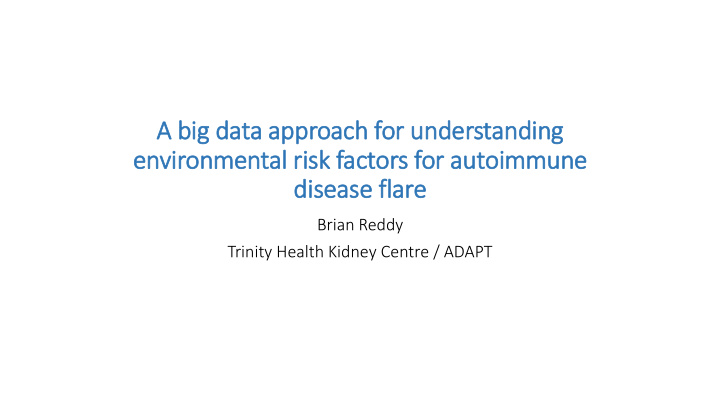



A big ig data approach for understanding environmental ri risk factors for autoimmune dis isease fl flare Brian Reddy Trinity Health Kidney Centre / ADAPT
• Autoimmune disease affects 15% of the population • Relapsing and Remitting
Background • ANCA vasculitis is a relapsing and remitting, rare autoimmune disease. • ‘Flares’ of the disease can result in rapid kidney impairment and destruction of other organs. • These cannot currently be predicted with accuracy. • Treatments to reduce the risk of flares occurring are toxic, and ideally should not be taken unless necessary. • Epidemiological data support a strong environmental impact relating to flare risk. • But it has proven difficult to identify exactly what environmental components are relevant, partially due to the rareness of the disease. • The AVERT study is aimed at stratification of the risk associated with disease at the patient level.
The role of the exposome • There have been major advances in the last 20 years in understanding human health, such as mapping the human genome. • But this has thrown up many new problems! • Genetics now thought to be responsible for as little as 10% of disease. • Environmental causes are believed to cause 70-90% of disease (Juarez et al. 2014) • The exposome the measure of all the exposures of an individual in a lifetime and how those exposures relate to health. • Application of IT infrastructure to environmental monitoring data could facilitate major advances in patient management.
Flare
Flare
Activity Location “How do I feel?” Flare
Activity Location “How do I feel?” Flare
Artificial intelligence Activity Location “How do I feel?” Flare
Artificial intelligence Activity Location “How do I feel?” Flare
Study hypothesis 1. Interaction between patient-level and environmental factors leads to relapse of PR3 ANCA vasculitis; 2. That the biological signal associated with this can be resolved by integrating highly granular longitudinal data using non-parametric regression, and; 3. These algorithms will be sufficiently robust to inform predictive machine learning at individual patient level.
Semantic web approaches • There are specific challenges associated with analysis of data at this scale, with careful planning required around the management and storage of data. • We are using a linked data model, the Resource Description Framework (RDF), to model and manage this information, which allows: • for different data sources and files to be easily understood (and combined) by both humans and machines; • quicker and more intuitive querying of data; • For the capturing of geographical features, and; • semantic reasoning to be applied to generate further enriched data.
The AVERT vision • Sharing • Role of RDF • Ethical issues • “Impossibility of anonymity”
Analysis • At most half of patients in study will have flares each year • This is a classic “large p, small n” study. It will take some years to build up sufficient numbers of flares for definitive answers. • There are virtually limitless variables available in principle that could include. Already it is clear that complexity will arise when trying to take into account: • Relevant/plausible lag times for explanatory variables • Interactions between explanatory variables • Our initial plan is to employ Bayesian Additive Regression Trees to find patterns, but will have plenty of time to plan. • For the time being this remains very much a project focussing on building up the infrastructure to allow this analysis in future, though we are testing similar approaches on historical data currently.
Conclusions • Flares of ANCA vasculitis - like many autoimmune diseases - appear to be associated in time and space with poorly understood environmental factors. • The community of vasculitis patients in Ireland is an engaged group of an appropriate size to attempt to gather sufficient data to better understand these. • The ultimate goal of AVERT is to allow patient-level risk factors to be better identified, allowing benefits and risks of anti-flare treatments to be weighed up. • More broadly, the approach may represent a new paradigm in managing chronic conditions governed by interaction between patient-level factors and their environment. • It may also blaze the trail for application of similar approaches for other (more common) autoimmune diseases
Thanks! Particular thanks to: • Mark Little • Lucy Hederman • Brett Houlding • Alan Meehan • Jason Wyse • Declan O’Sullivan Contact: reddybr@tcd.ie @imirtpele
Recommend
More recommend